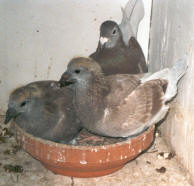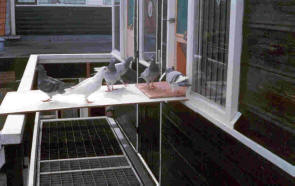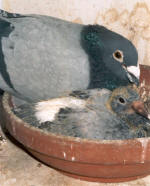Method
The only pigeons which are raced are widowhoodcocks. Occasionly one single yearling hen (living between the youngsters) is raced while breeding, f.e. in 2003 the first arriving pigeon on national race from Dax was a yearling raising a one week old baby. No further hens are raced sof ar due to a lack of time. Besides working hours time is too limited to also train and motivate them.properly.; already before even racing the youngsters this is taken into consideration as female youngsters are partly given away of not trained at all so that most of the available loftspace can be used for the future widowhoodcocks. It’s simply a question of not putting time and effort in pigeons which won’t be raced in future anyhow.
In principal all yearling cocks, in principal, raise, after being
moved to the loft of the widowhoodcocks direclty after the racing season
and mated around the end of December offspring to make them more
comfortable in their new environment. Most of the time the offspring
they raise is that of the stockbirds, which at that time can start a
second breed. The same goes for the older short distance birds which
after this breeding period again are mated at the beginning of April
and breed for max. 5 days to avoid moulting to start too early in the
season. . The old cocks for the long distance races (2 day races) only
breed one time for a period of max. 5 days; most of the time they are
mated, together with the yearling long distance cocks (who then breed
for the second time) around the 20th of April. A lot of the older cocks
haven’t raised any offspring for years. Also after finishing the racing
season most of the time no breeding will take place. After a long racing
season and a moulting period coming up the birds is given rest.



Youngsters raised in January are raced unseparated as long as they are basketed on Friday, although breeding is not allowed. As soon as we start basketing on Thursday they are separated and raced “on the door”, cocks and hens separated from Saturday evening until two hours for basketing. Unfortunately most of the time this doesn’t result in an improvement in results (most likely because of the limited number of hens still present…) but saves time as widowhoodcocks and young cocks can be trained together.
Very often there
also breeded some young pigeons during May. Those are trained in the
september-races and – if possible – also are basketed on the last few
races of the “normal” program for youngsters.
The young pigeons breeded in January are kept in the dark for 8 weeks,
those from May only 5 to 6 weeks, just long enough to keep well until
the end of August. After that date the search for a pigeon who can be
basketed starts…….Only pigeons breeded in May are raced (together with
some of January breed which were hurt or went missing for some time),
older hens or widowhoodcocks are never raced
than.
With regard to care, lodging and traing the goal is to keep it all as simple as possible, f.e. older pigeons are only fed once a day (evening), youngsters once every morning. In the past schedules from well-known suppliers were followed but nowadays the challenge is to keep it all simple (and cheap !). For old hens and cocks a quality brend is used together with some grit and minerals, sometimes while racing some amino acid is added.
All pigeons are vaccinated against parathyphoid and paramixo and treated for trichomonasis. A couple of weeks before the races a treatment for the bronchial tubes is scheduled. Young pigeons get the “A.S.-junior”-brend from Teurlings and sometimes some vinegar in their water. If possible they are not treated with medication.
Both young and old pigeons only train once every day, hens are never trained at all. Old cocks all train together in spite of the fact what distance they are to race.
Long-distance cocks
(2 day races) usually are basketed for several races for totally appr.
1000 km before the first serious long-distance race is scheduled. In
contradiction to what most of the long distance fanciers do, only start
playing the long-distance cocks as from May, everything is basketed from
the first race if the weather is acceptable. Why wait for eventual (!)
good weather conditions in May when you already have it in April ?
Waiting until May might force one in a position that he has to basket
even when weather is less perfect.
Yearling pigeons destined for long-distance as a rule are raced 7 to 8
times and at the end of the season also are basketed for the shortest
long-distance race (appr.
850 km). The
training schedule includes two races of appr. 600 km. On this shortest
long-distance race, usually Bergerac, older pigeons are never basketed.
Widowhoodcocks for
short distance races and youngsters are raced weekly; after appr. 6
races a first selection is effected and a part of the team stays at the
loft for the rest of the season.
Directly after the last race in September the final selection is
effected, the pigeons are separated and the pigeons can rest and prepare
for moulting.